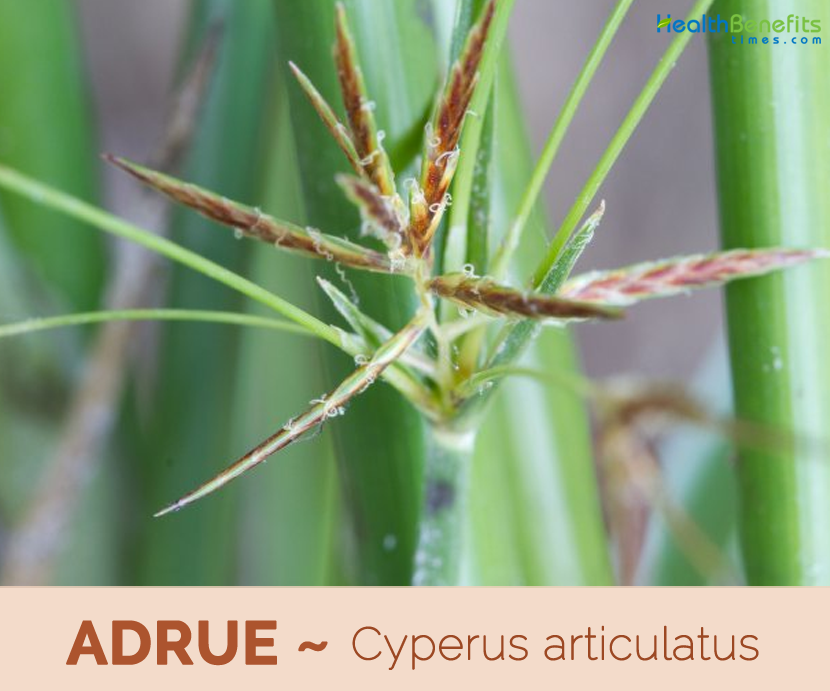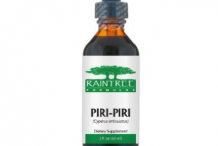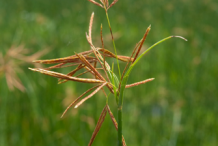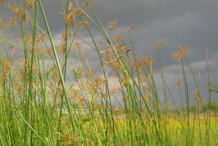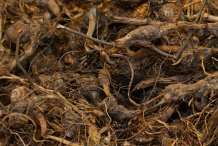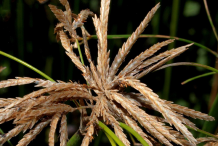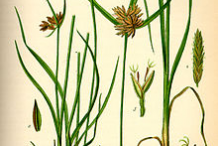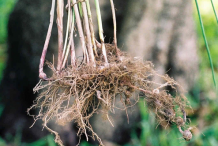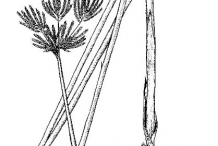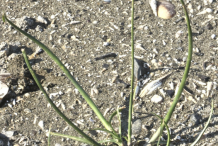It is used by the cosmetic industry, and increasingly as a flavoring for food. The root is used to make medicine. It is used to stop vomiting and to treat digestion problems including nausea, colic, and gas. It is also used as a calming agent (sedative).
Plant Description
Adrue is perennial rhizomatous sedge that grows over 6 feet (2 meters) in height. The plant is found growing in ponds, ditches, rivers, marshes, lakes and banks of canals of shallow water. It also occurs in still or weakly running water, sometimes alternatively fresh and salted water. It forms great reed marsh on temporary unflooded soils. It prefers moist or wet soil and can grow in water. It grows in clumps from dividing rhizomes which are about 2 cm long and 1.5 cm in diameter. The stems are fibrous, cylindrical, hollow and can be as large as 3/4 of an inch (2 cm) in diameter at the base. The stem narrows as it grows upward turning into spiked blades of shiny grass, which range in color from bright yellow-green to dark forest green, and can project a purplish inflorescence under the right lighting conditions. During the summer season, the grass produces many tiny white flowers at the top of the stalk, which has been termed as being similar to the tiny white flowers produced by wheat grass.
Its leaf blades are completely absent and it has scale-like involucral bracts measuring less than 15 mm long. The anthers are 1.0-1.5 mm long and the floral glumes are 2.25 to 3.5 mm in length. Piri-piri stems have sometimes been used like reeds in basket-making and other crafts by the locals in the Amazon.
Traditional uses and benefits of Adrue
- The French Guiana Palikur rubs the pounded stem on the nose to control snoring.
- The plant is used in the treatment of nausea, vomiting, stomach pains, intestinal gas, headaches, colds, flu, mouth sores and ulcers, and hypertension.
- Externally, it is used to treat snake bites and prevent baldness.
- It is particularly valued for its beneficial effect upon the digestive system and is commonly used to treat nausea, vomiting, stomach-aches, and intestinal gas.
- The plant is anthelmintic, antibacterial, antiemetic, antifungal, carminative, contraceptive, digestive, febrifuge and sedative.
- Plants are possible use in treating conditions such as epilepsy and convulsions.
- The fresh rhizomes are ground up to extract the juice, which is used as a nerve tonic in cases of stress and nervous and mental disorders.
- It is also used to treat and prevent a wide range of digestive and gastrointestinal disorders; to treat fevers and flu; to facilitate child birth or to induce an abortion; as a contraceptive; and for throat cancer.
- Externally, it is used to heal wounds and treat snake bite, whilst it is also put on the head as a hair tonic and to treat or prevent baldness.
- A leaf infusion is used for treating headaches; colds and flu; mouth sores and ulcers; and hypertension.
- Whole plant is decocted to relieve nausea and vomiting caused from malaria.
- The Sharanahua Indians use Cyperus articulatus to reduce high fevers, soothe upset stomachs, and induce sweating, which they believe expels evil spirits and disease.
- Piri Piri roots are made into a tea to treat digestive aid, to calm nervous anxiety, as a sedative and tranquilizer.
- The Karipúna-Palikúr Indians of Guiana use Piri Piri to treat the symptoms of malaria, and to help quell nausea.
- It is also used as a hair tonic to help fight baldness, a treatment for severe flu symptoms, and relief for headache and migraine pain.
- Native tribes in Central America have used this grass to relieve the pain caused by sensitive teeth and toothaches.
- The Shipibo-Conibo Indian tribes from the Peruvian rainforests make a nerve tonic from the roots of the grass, which helps to calm epileptic seizures and psychological imbalances.
- The Secoya Indians use the roots to make a medicine that they believe cures influenza, relieve anxiety induced stress and to calm frightened children.
- In Africa, piri-piri is used for malaria, toothaches, headaches, diarrhea, indigestion and coughs.
Other facts
- Piri piri stems are used in making baskets, mats, sacks, and other crafts.
- Essential oil from the rhizome is used in perfumery.
- Rhizome can be dried or burnt and used as incense and as a mosquito repellent.
- The plant can also be grown along the banks of streams to prevent soil erosion.
- Stems are used for weaving into mats.
- Fragrant, sweet-scented, tuberous roots are used for perfuming clothing etc.
- Cyperus articulatus is largely pastured by cattle when nothing else is available.
- Women cultivate the plant and bathe their children with it to prevent sickness and injury, and give it to their husbands to bring good luck in hunting and fishing.
Precautions
- Avoid use during pregnancy and breast feeding.
- Avoid in individuals with a known allergy or hypersensitivity to jointed flats edge or any members of the Cyperaecae family.
- Use caution if driving or operating heavy machinery.
References:
https://www.itis.gov/servlet/SingleRpt/SingleRpt?search_topic=TSN&search_value=39908#null
https://davesgarden.com/guides/pf/go/135467/
https://npgsweb.ars-grin.gov/gringlobal/taxonomydetail.aspx?id=12899
http://www.pfaf.org/user/Plant.aspx?LatinName=Cyperus+articulatus
https://www.botanical.com/botanical/mgmh/a/adrue011.html
http://www.theplantlist.org/tpl1.1/record/kew-235716
https://plants.usda.gov/core/profile?symbol=Cyar4
http://entheology.com/plants/cyperus-articulatus-piri-piri/
https://en.wikipedia.org/wiki/Cyperus_articulatus
Comments
| Adrue Quick Facts | |
|---|---|
| Name: | Adrue |
| Scientific Name: | Cyperus articulatus |
| Origin | Africa, temperate and tropical Asia, Australia, north and south America |
| Shapes | Nutlet dark brown, 3-angled, shiny |
| Taste | Bitter |
| Name | Adrue |
|---|---|
| Scientific Name | Cyperus articulatus |
| Native | Africa, temperate and tropical Asia, Australia, north and south America and naturalized elsewhere |
| Common Names | Guinea Rush, jointed flatsedge, priprioca, chintul, piripiri, adrue |
| Name in Other Languages | Arabic: But, dis mudwir (dys mddawr) بوط، ديس مدور (ديس مدَّور), saed (sied, saed), dys (dis) سعد (سِعْد، سَعْد)، ديس (دِيس),, samar (samar, sumar) سمار (سَمار، سُمار) Chinese: Xiang fu English: Guinea Rush, jointed flatsedge, priprioca, chintul, piripiri, adrue Spanish: Huaste, piripiri de víbora |
| Plant Growth Habit | Perennial rhizomatous sedge |
| Growing Climate | Found growing in ponds, ditches, rivers, marshes, lakes and banks of canals of shallow water |
| Soil | Prefers moist or wet soil and can grow in water |
| Plant Size | Over 6 feet (2 meters) in height |
| Tuber | 0.7-1 in (1.1-2.5 cm) long and about 0.5-0.7 in (1.3-1.7 cm) in diameter |
| Rhizome | Long-creeping, thick rhizome that is 2 cm long and 1.5 cm in diameter |
| Stem | Fibrous, cylindrical, hollow and can be as large as 3/4 of an inch (2 cm) in diameter at the base |
| Flower | Many tiny white flowers at the top of the stalk |
| Fruit | Nutlet dark brown, 3-angled, shiny |
| Flavor/Aroma | Smells a little like lavender |
| Taste | Bitter taste |
| Plant Parts Used | Rhizome |
| Culinary Uses |
|


